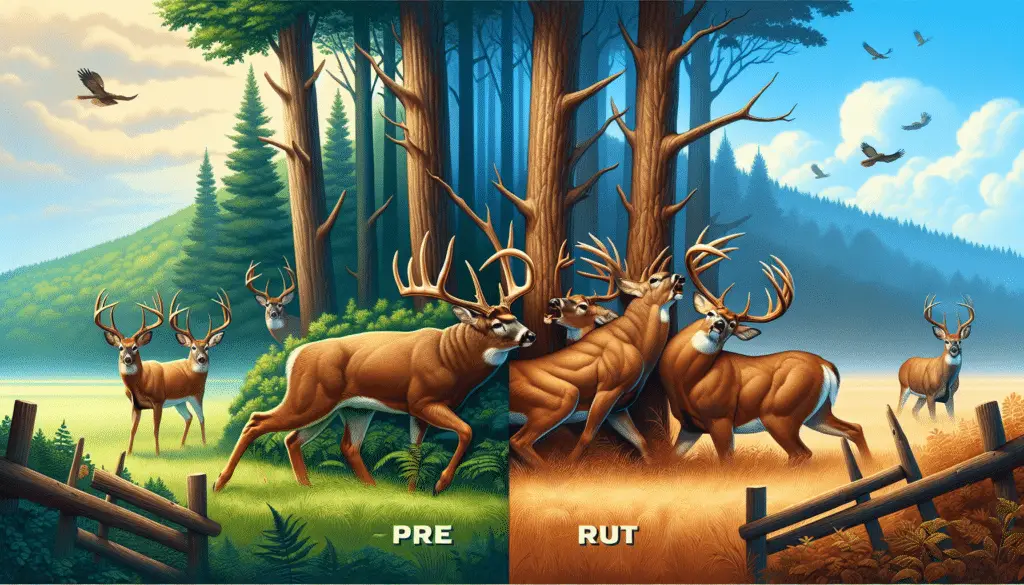Understanding Deer Behavior: Pre-Rut Versus Rut
Table of Contents
ToggleWhen fall arrives, deer hunters start to witness significant changes in deer behavior.
This transformation phases through two main periods known as the pre-rut and the rut.
What is the Pre-Rut Period?
The pre-rut is the lead-up to the main breeding season.
This period is marked by a gradual change in buck behavior as they prepare for the rut.
Identifying Pre-Rut Activities
During early to mid-October, bucks become more active in establishing territories.
They do this by making scrapes and rubs, which are visual and scent markers.
The Role of Scrapes and Rubs
Scrapes are areas where deer paw the ground and urinate, often found near trees or on paths.
Rubs are markings on trees where bucks have stripped the bark, typically with their antlers.
Strategies for Pre-Rut Hunting
Key strategies include locating active scrapes and setting up trail cameras.
Another method is to set up near rub lines since they indicate regular buck movement.
Choosing the Best Location
Bucks are territorial during pre-rut, making it critical to find travel corridors.
Finding the transition areas between bedding spots and food sources can also be productive.
Use of Hunting Scents
During the pre-rut, hunters can use scents like doe urine to attract bucks.
These scents mimic the smell of a doe in the area and can bring a buck in search of a mate closer.
What Attractants Work Well During the Pre-Rut?
One of the popular products for attracting bucks is the Wildlife Research Center’s Golden Estrus.
It’s said that this scent attractant can make a significant difference in drawing bucks closer for a shot.
Timing Your Hunt
The timing of your pre-rut hunt is also essential.
Being in the stand at dawn and dusk when bucks are most active can increase the odds of success.
What is the Rut?
The rut is the breeding period when bucks are singularly focused on finding does.
This usually occurs from late October through November, depending on your location.
Behavior Changes During the Rut
Bucks can become more aggressive and throw caution to the wind in pursuit of does.
It’s during this time that you might see bucks chasing does in daylight hours.
Hunting Tactics for the Rut
Because bucks are on the move, being mobile and ready to adapt is critical.
Hunters can take advantage of this by using calls and rattling antlers to imitate buck or doe sounds.
Understanding the Peak of the Rut
The peak rut phase is when does are in estrus and most receptive to mating.
It’s during this time that the activity can be most intense, with bucks traveling long distances to find a mate.
Advantages of Hunting During the Rut
Many hunters consider the rut the best time to harvest a big buck.
Bucks are less cautious and more visible as they move throughout the day.
Challenges of Rut Hunting
However, hunting during the rut can be unpredictable.
Bucks may move at any time, and traditional patterns seen in pre-rut can become irrelevant.
Decoys and Calls in Rut Hunting
Decoys paired with grunt calls or doe bleats can be effective during the rut.
These create the illusion of a receptive doe or a rival buck, which can draw in a mature deer.
Comparing Pre-Rut and Rut Tactics
While both periods offer opportunities, tactics differ greatly due to the changing behaviors of the deer.
Preparing different strategies for pre-rut and rut can significantly enhance your hunting success.
What Hunting Gear Can Aid During the Rut?
An example of effective gear is the Primos Buck Roar Call.
It’s designed to replicate the deep, resonating roar of an aggressive buck.
According to reviews, this product has been highly successful in getting the attention of dominant bucks during rut.
Maximizing Your Pre-Rut and Rut Experience
To make the most of these periods, thorough preparation is necessary.
Understanding deer biology, scouting, and adapting to the nuances of deer behavior can all contribute to a successful hunt.
What Are the Behavioral Cues to Look For?
Indicators like increased rubbing and scraping are telltale signs of the pre-rut.
During the rut, look for chasing behavior and listen for buck grunts.
Gearing Up for Hunting Success
Find reliable gear that can handle the rigors of fall hunting through the pre-rut and rut seasons.
Proper clothing, scents, and calls are all critical to enhance your hunting tactics.
Strategic Use of Decoys and Calls During Pre-Rut
As part of pre-rut tactics, the strategic use of decoys and calls can be invaluable.
During this time, bucks are starting to stake out their territory and are receptive to challenges from what they perceive to be intruders.
Utilizing grunt calls can mimic a young buck challenging the older, more dominant bucks, drawing them out into the open.
Similarly, a doe decoy could spark curiosity or territorial aggression, making it a potential game-changer.
But remember, moderation and realism are key; overuse can alert deer to your presence and backfire on your hunting efforts.
Transitioning to Rut: Recognizing the Shift
Recognizing the shift from pre-rut to rut is crucial for adapting your hunting strategy.
You may begin noticing does acting skittish as bucks increase their pursuits.
Such shifts indicate a change in gears for bucks who are now willing to venture out of their comfort zones in search of does.
This period of heightened activity can result in what hunters refer to as the ‘chase phase’ leading up to the peak rut.
The Importance of Weather Conditions During Pre-Rut and Rut
Weather plays a significant role in deer movement.
Drops in temperature, for example, can stimulate deer activity and make them more predictable.
Pre-rut and rut phases often coincide with the onset of colder weather, which can encourage deer, especially mature bucks, to start moving more frequently in search of mates.
So, keeping an eye on the weather forecast can be just as important as scouting for signs of deer activity.
Maximizing the Effectiveness of Scents
When it comes to scents, identifying when to switch from curiosity or territorial scents to mating scents is key as you transition from pre-rut to rut hunting.
With the rut’s increased activity, does are coming into estrus, and so the scent game changes.
Products like Code Blue Doe Estrus can be very effective during this time.
Based on reviews, hunters have noted an increase in buck activity in their hunting areas after using this product.
When strategically placed, it can mimic a doe’s trail, leading bucks right to your waiting stance.
Find This and More on Amazon
Leveraging the Moon Phase
The lunar cycle is another factor that hunters should take into account.
Some studies suggest that the intensity of the moonlight can affect deer movement, where a full moon may increase nighttime activity, and thus decrease daytime sightings.
It’s beneficial to consult a moon phase calendar and plan your hunting times accordingly, considering the potential for nocturnal activity.
Adapting to Changes in Deer Patterns
It’s essential to note that the constant during both pre-rut and rut is change.
Deer will modify their routines in response to hunting pressure, food availability, and the presence of other deer.
Adaptability is a vital skill for hunters; being able to adjust locations, strategies, and tactics on the fly can make the difference between going home empty-handed or with a trophy.
Trail Cameras: A Hunter’s Best Tool
With advancements in hunting technology, trail cameras have become a staple in a hunter’s toolkit.
These devices can provide invaluable insight into the times when deer are most active in your area, peak activity periods, and frequent patterns among both does and bucks during the pre-rut and rut phases.
A reliable trail camera like the Browning Strike Force Pro XD has been lauded for its dual-lens technology that captures remarkably clear images, day or night.
Investing in such a camera can pay dividends in understanding the shifts in deer behavior.
Find This and More on Amazon
Blinds and Tree Stands: Positioning for Success
Where you position your blind or tree stand during these phases can significantly impact your hunting success.
During pre-rut, consider places that offer clear views of scrapes and rub lines.
As you move into the rut, positioning near doe bedding areas or along corridors that connect food sources may give you a better chance of encountering a buck following a doe.
Ensure that your blind or stand is well-hidden to avoid spooking deer.
The Need for Stealth and Patience
Regardless of what phase of the deer breeding cycle you’re hunting in, stealth and patience are virtues.
Remember, deer are vigilant animals with acute senses.
Practicing scent control, moving quietly, and being patient can be just as critical as being in the right place at the right time.
Final Thoughts on Pre-Rut versus Rut Hunting
Hunting during pre-rut and rut involves understanding intricate behaviors and requires a nuanced approach.
The ability to interpret environmental clues, shift strategies, and utilize various tools and tactics can lead to successful hunts during both periods.
Ultimately, success will come down to preparation, observation, and the hunter’s instinctive ability to pursue their quarry.



